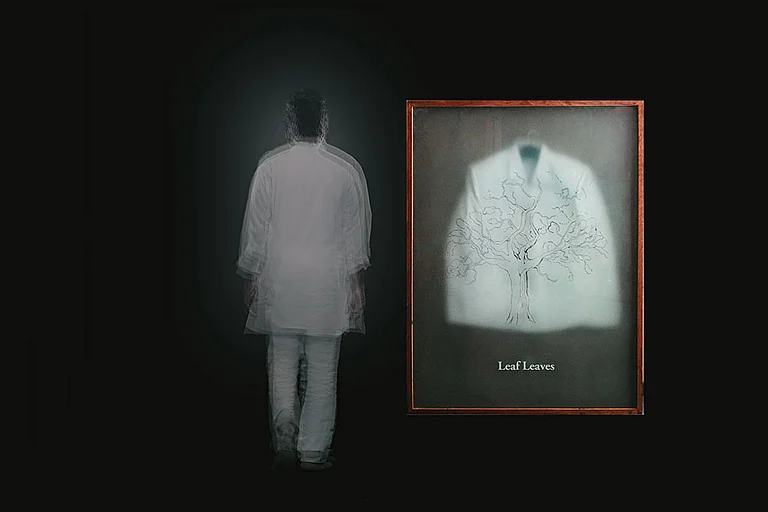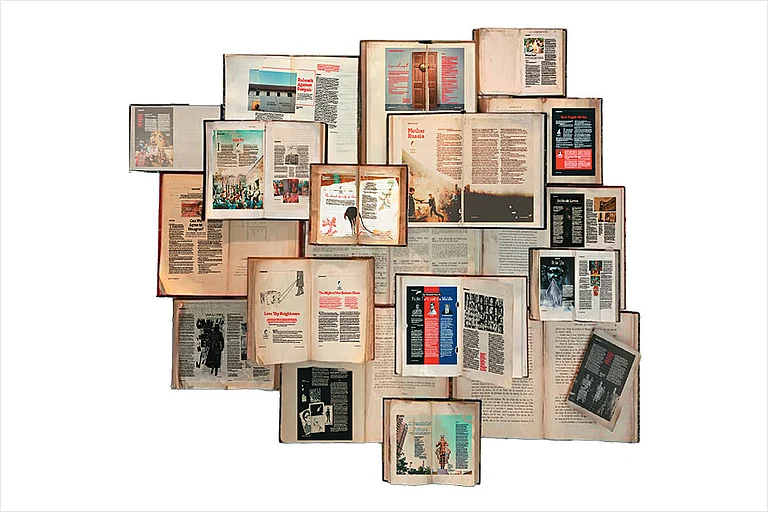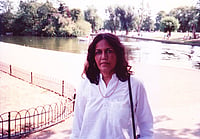Mumtaz Shireen (1924–1973), born a hundred years ago this week on September 12, is a significant name in the landscapes of the Urdu short-story and criticism. As the first major female Urdu critic, Shireen has considerable importance. Her short-story collections Apni Nagariya (One’s City) and Megh Malhar (Megh Malhar) and a collection of English short-stories Footfalls Echo are precious assets of Urdu literature. All clear-sighted people are aware of her work in the field of translation in addition to her critical essay collections Me’yar (Standard), Nuri Na Nari (Neither Heavenly Nor Hellish) and Zulmat-e-Neem-Roz (Darkness At Noon). Her critical essays deserve to belong to the category of creative critique, in which practical critique and ideological debates coexist. Shireen’s short-stories on account of style and singularity of expression stand out in Urdu literature. Her work enriched the Urdu short-story immeasurably.
It is especially worth mentioning that due to her command over Urdu, English, Farsi, Hindi, Kannada, Turkish and French, Shireen carved out a prominent and distinguished identity. Taking full advantage of skill, she made important additions to the corpus of Urdu translation.
This piece is my humble contribution towards introducing her to readers who may be unfamiliar with her, and shedding more light on her personality and art.
Since the start of the 20th century, many important names of Urdu literature have shone in the fields of the short-story, translation and criticism. Shireen is one of these names, who guided minds towards research and inquiry, opened doors, made the Urdu-wallahs aware of new debates, and encouraged new writers.
In terms of the modern short-story, at a creative and critical level, Shireen has gifted fiction writers, readers and critics beauty and merit. This aspect of her literary character continues to give writers and critics of every era new standards of excellence. On the basis of the stages of gradual evolution which Shireen passed through in the art of short-story writing, it is apt to say that she has "collectively established a standard”.
In her writing, she introduced the Urdu short-story from new angles, experimenting with technique and the singularity of style. Her short-stories are important not merely because she uses an evolved vocabulary in her fiction, reflecting the most modern trends and movements occurring on the international short-story scene in her time. She was also fully aware of the issues in her neighbourhood. She had the power to present sensuous internal revolutions and changes. Excellent at writing dialogue related to diverse topics, she cultivated an evolved style and tone in her short-stories.
In the context of the women short-story writers of the 1940s, Shireen can be credited with making girls from the middle-class and female teachers the topic of conversation through her writing. The tales of teacher-student atrraction have always had a readership. A teacher selecting a favourite, or a girl student gifting her flowers and longing for her secretly– all these are the result of the suffocation which exists because males are deemed "forbidden", but the body demands what it yearns for. Young women confined to schools and mansions as if they are housed in cattle pens, the wives of the sons of nawabs, the girls going to school wrapped up in purdahs, working teachers imprisoned in burqas–how can they breathe, if at all? All these aspects are introduced in Shireen’s unforgettable short-story Angdai (Retribution)
The lives of maidservants, governesses and nurses find a place in Shireen’s short-stories. She was the first very learned woman of Urdu literature, especially acquainted with French and English literature and criticism and the writings of contemporary writers. Her stories portray multi-cultural societies in which same-sex relationships exist; there is Ms Finance, Zubaida, Joan, the professor and Gulnar, the mention of short hair, lipstick and rouge.
The most important aspect of her uniqueness in terms of criticism is that she did not write under the influence of textbook requirements but used extreme balance and moderation. Especially while critiquing the short-story, impressed with modern literary movements, she introduced different techniques of World Literature. But her distinctive effort in this process has been that instead of precisely applying the yardsticks of Western literature here, she endeavoured to create a balanced mingling of the East and the West. As a result of this, our literary tradition comes to the fore on the one hand and on the other, the harmony of Urdu literature and the traditions of World Literature also becomes possible.
Despite her important and diverse scholarly and literary services, the work done on her to date has not been at the level she deserves. Especially in the light of that fact after the creation of Pakistan, along with highlighting the features of Pakistani literature, she also made valuable efforts for the defense of Pakistan’s ideological foundations. As a writer, she considered some ideal necessary for the reflective growth of the artist and for her, Pakistan too was very much a message.
Shireen is counted as one of the few writers in Urdu literature with extremely scholarly perception. She also wrote beautiful short-stories embellished with modern trends; and expanded the breadth of Urdu through translations of the world’s best short-stories. Her natural elegant taste is apparent from both these references. She was not only a good short-story writer but possessed the highest consciousness to evaluate the standards of the art of short-story writing as well. She may undoubtedly not be considered one of the three best Urdu short-story writers but her skill, literary consciousness, creative sensitivity and intelligence have contributed immensely to the Urdu short-story and its critique. As a woman fiction writer, Shireen emerged from the circle of suppressed, suffocated and limited ideas to use an expanded reflective standard for the topical sequence of her short-stories, presenting themes from such a world, of which most readers are aware of and familiar with. From this angle her uniqueness in the history of the Urdu short-story is indisputable.
She was also a superb literary critic, presenting epoch-making debates on trends and ideologies and also supplying the best models of practical critique. Thus her individual status in Urdu criticism becomes two-fold.
As a journalist and editor-cum-manager of a literary journal of high stature too she built a prominent identity. An effort to protect the real spirit of the original story while translating it is the special feature about her translations. Her letters to celebrities, contemporary writers and friends not only highlight various aspects of her personality but also cover all aspects of the literary history, trends, issues and activities of the time beautifully. These letters also unveil the hidden corners of Shireen’s life which inform us about her tolerant and amiable personality.
The services of Shireen and Samad Shaheen (her husband) will remain memorable in literary journalism. Their journal Naya Daur (New Era) was issued from Bangalore in 1943 and after continuing from Karachi after 1947 for a few years, it closed down. This journal proved to be a milestone in Urdu literary journalism. Their friends and important personalities of literary circles are unanimous in the opinion that in a personal capacity, cordiality, calmness and cheerfulness were prominent aspects of Shireen’s personality.
Her incomplete autobiography Hameen So Gaye Dastan Kehte Kehte (We Ourselves Slept While Telling the Story) makes visible those hidden aspects of her personality, which help us understand the contrary aspects of her literary personality. In terms of critique and creation, a few analysts are of the opinion that she has tried to make up for a deficiency of suitable balance in both of these with the help of her wide reading and open-mindedness that springs from humility. She had impressed her readers and the literary circle of the time as a short-story writer with her very first story. Her initial critical essays had made every reader interested in literary criticism acquainted with her abundant knowledge and wide reading.
Her boundless curiosity, breadth of reading, interest in literary trends and modern literary experiments led to her gradual evolution in the art of short-story writing. Her short-stories, in view of their topical presentation and technique, bring forth her unique singularity. In contrast with the women short-story writers of her time, a kind of peace, comfort and contentment can be seen in her work. The success of humanity and human bonds, and the creation of a regulated and organised system based on human foundations was her aim, which she successfully presented in her short-stories.
In terms of theoretical and practical critique, she has given a reflective and practical capital of high value to Urdu criticism. In this context, in addition to other topics, she gave special attention to the critique of the short-story. She undertook an in-depth study of the eminent short-story writer Saadat Hasan Manto. Even today, only a few take up the arduous journey of criticism in the Urdu language and the contribution of women is not much as well. But when Shireen began writing criticism, the attention the literati gave to this field was even lesser, especially with reference to the criticism of fiction.
Shireen, while accepting the influence of modern reflective movements, presented a beautiful and balanced mingling of the critical attitudes of the East and the West, the likes of which is seldom found. At least in the Urdu world, she will be counted as an exception.
One of the objections raised against her is that the short-stories of her final period seem like mere artistic experiments, which fail to cover all aspects of life. Despite this criticism, it is not possible to reject the importance of these experiments. Rather, it can be said that had she been allowed more time, then perhaps she herself would have exploited these experiments better.
Shireen possessed the unparalleled ability to understand and analyse the feelings of an artist with the help of the mutual attachment of creation and criticism. These attempts of hers not only acquainted the Urdu short-story with new experiments but also illuminated fresh prospects for Urdu short-story writing and raised scholarly questions with reference to the art and techniques of short-story writing. On the basis of these, new paths began to open up for the Urdu short-story. For determining literary priorities, she presented ideas based on progressive trends with the help of which the Urdu short-story embraced boundless dimensions by emerging from the limited world of feelings and impressions. Thus, she proved to be authentic with reference to both the critique and the creation of the Urdu short-story.
In the last few years of her life, her creative activities had decreased. But people who were in touch with her were well aware of her literary projects and creative activity. She used to have interesting conversations about new books and literary trends in private sittings with like-minded friends. Unfortunately, severe illness ended her life and death deprived her of the chance to carry on writing.
Shireen is one of the beloved women of Urdu literature, who had expertise in English and Urdu and wrote in both languages. She has left a permanent impression on both creation and critique. As a short-story writer, editor, critic and translator, her literary writings made Urdu readers pay attention. The most important thing to be remembered is that in a very short period of time, she gave Urdu literature what even some great writers could not give in their lifetimes.
(The writer is a Lahore-based writer, critic, translator and researcher. He is translating Mumtaz Shireen’s short stories and unfinished autobiography. He can be reached at: razanaeem@hotmail.com. He tweets @raza_naeem1979)



















.jpg?w=200&auto=format%2Ccompress&fit=max)





